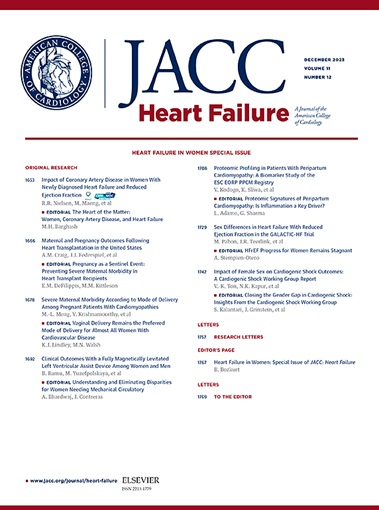Effects of Acute Phase Intensive Exercise Training in Patients With Acute Decompensated Heart Failure
IF 10.3
1区 医学
Q1 CARDIAC & CARDIOVASCULAR SYSTEMS
引用次数: 0
Abstract
Background
Acute decompensated heart failure (ADHF) leads to hospitalizations and functional decline in older adults. Although cardiac rehabilitation (CR) is effective for stable heart failure, its impact on ADHF patients, particularly those without frailty, is unclear.
Objectives
The goal of this study was to evaluate the efficacy and safety of early in-hospital CR for patients hospitalized with ADHF who are not frail.
Methods
In this multicenter trial (ACTIVE-ADHF [Effects of Acute Phase Intensive Exercise Training in Patients with Acute Decompensated Heart Failure]), ADHF patients without physical frailty were randomized 2:1 to undergo either exercise-based CR or standard care. The intervention included early mobilization and structured exercise training. The primary outcome was the change in 6-minute walk distance (6MWD) from baseline to discharge. Secondary outcomes assessed physical and cognitive function, quality of life, and safety.
Results
A total of 91 patients were randomized to treatment, with 59 allocated to the intervention group and 32 to the control group. The primary outcome, 6MWD, improved significantly more in the intervention group, with a mean increase of 75.0 ± 7.8 m vs 44.1 ± 10.2 m in the control group, with an effect size of 30.9 ± 13.1 m (95% CI: 4.8-57.0; P = 0.021). The intervention group showed favorable results in secondary efficacy outcomes, including physical and cognitive function, physical activity, and quality of life. Safety outcomes were similar between groups, except for a greater reduction in B-type natriuretic peptide levels at 90 days’ postdischarge in the intervention group.
Conclusions
In patients with ADHF without physical frailty, in-hospital exercise-based CR led to significant improvements in 6MWD at 2 weeks after randomization without compromising safety. (ACTIVE-ADHF [Effects of Acute Phase Intensive Exercise Training in Patients with Acute Decompensated Heart Failure]; UMIN000020919)
急性期强化运动训练对急性失代偿性心力衰竭患者的影响。
背景:急性失代偿性心力衰竭(ADHF)导致老年人住院和功能下降。虽然心脏康复(CR)对稳定型心力衰竭有效,但其对ADHF患者的影响,特别是对那些没有虚弱的ADHF患者的影响尚不清楚。目的:本研究的目的是评估早期住院CR对非体弱ADHF住院患者的疗效和安全性。方法:在这项多中心试验(ACTIVE-ADHF[急性失代偿性心力衰竭患者急性期强化运动训练的影响])中,没有身体虚弱的ADHF患者按2:1随机分组,接受基于运动的CR或标准治疗。干预包括早期动员和有组织的运动训练。主要结局是6分钟步行距离(6MWD)从基线到出院的变化。次要结局评估身体和认知功能、生活质量和安全性。结果:91例患者随机接受治疗,干预组59例,对照组32例。干预组的主要终点6MWD改善明显更多,平均增加75.0±7.8 m,对照组平均增加44.1±10.2 m,效应量为30.9±13.1 m (95% CI: 4.8-57.0;P = 0.021)。干预组在次要疗效指标,包括身体和认知功能、身体活动和生活质量方面显示出良好的结果。除了干预组在出院后90天b型利钠肽水平下降幅度更大外,两组之间的安全性结果相似。结论:在没有身体虚弱的ADHF患者中,在随机分组后2周,基于住院运动的CR可显著改善6MWD,且不影响安全性。ACTIVE-ADHF[急性期强化运动训练对急性失代偿性心力衰竭的影响];UMIN000020919)。
本文章由计算机程序翻译,如有差异,请以英文原文为准。
求助全文
约1分钟内获得全文
求助全文
来源期刊

JACC. Heart failure
CARDIAC & CARDIOVASCULAR SYSTEMS-
CiteScore
21.20
自引率
2.30%
发文量
164
期刊介绍:
JACC: Heart Failure publishes crucial findings on the pathophysiology, diagnosis, treatment, and care of heart failure patients. The goal is to enhance understanding through timely scientific communication on disease, clinical trials, outcomes, and therapeutic advances. The Journal fosters interdisciplinary connections with neuroscience, pulmonary medicine, nephrology, electrophysiology, and surgery related to heart failure. It also covers articles on pharmacogenetics, biomarkers, and metabolomics.
 求助内容:
求助内容: 应助结果提醒方式:
应助结果提醒方式:


